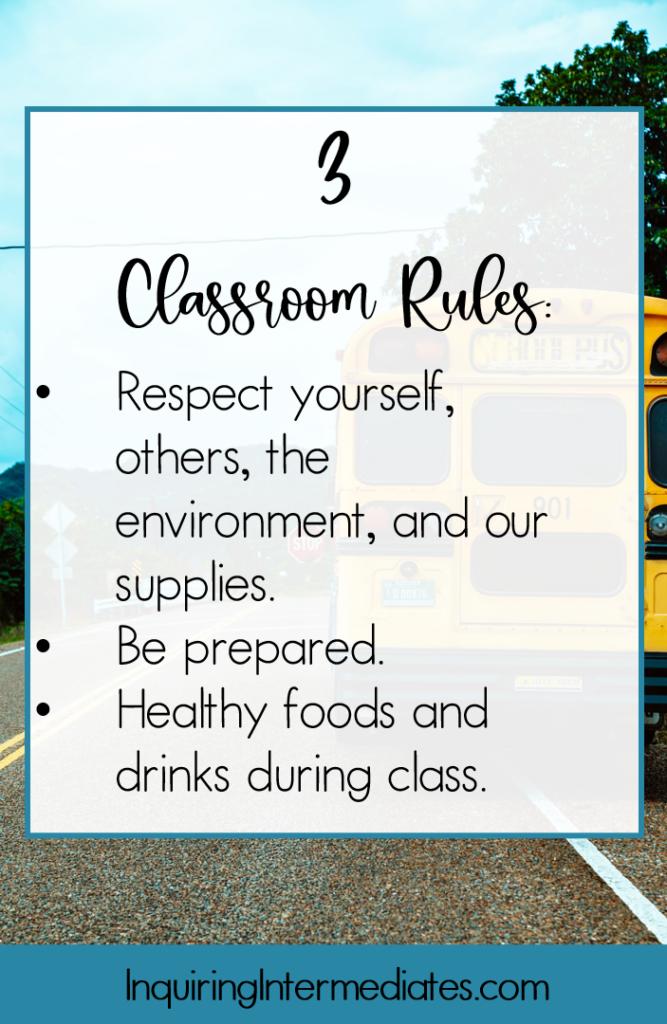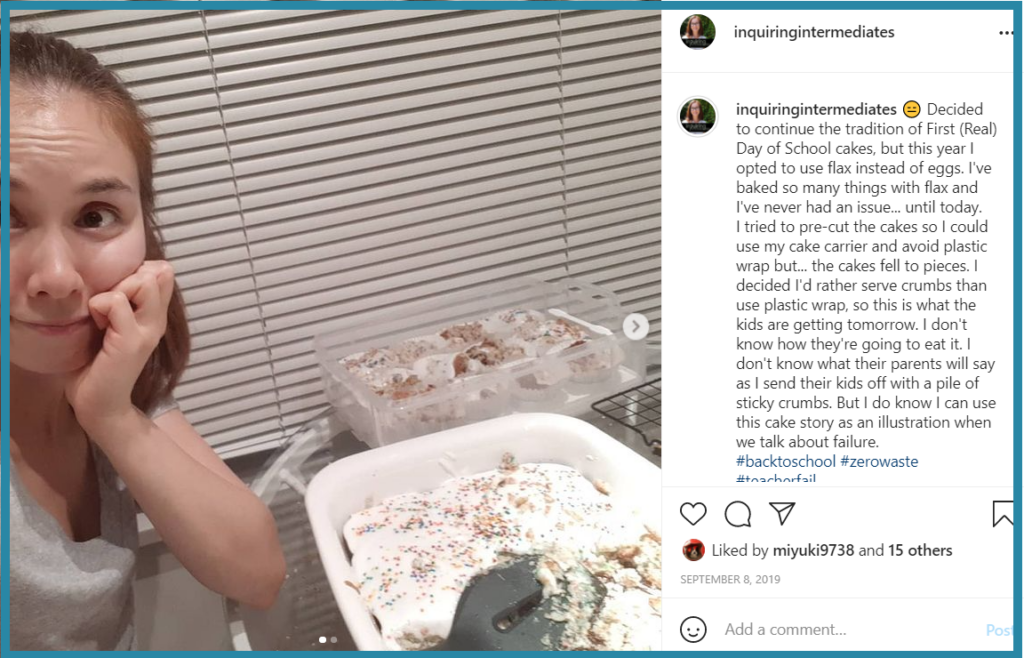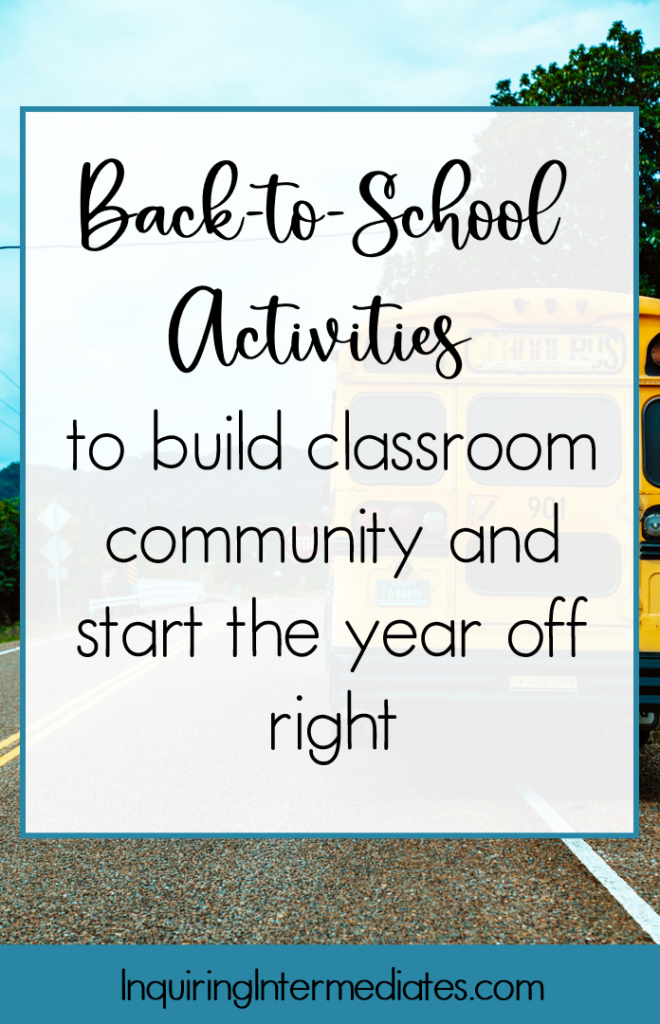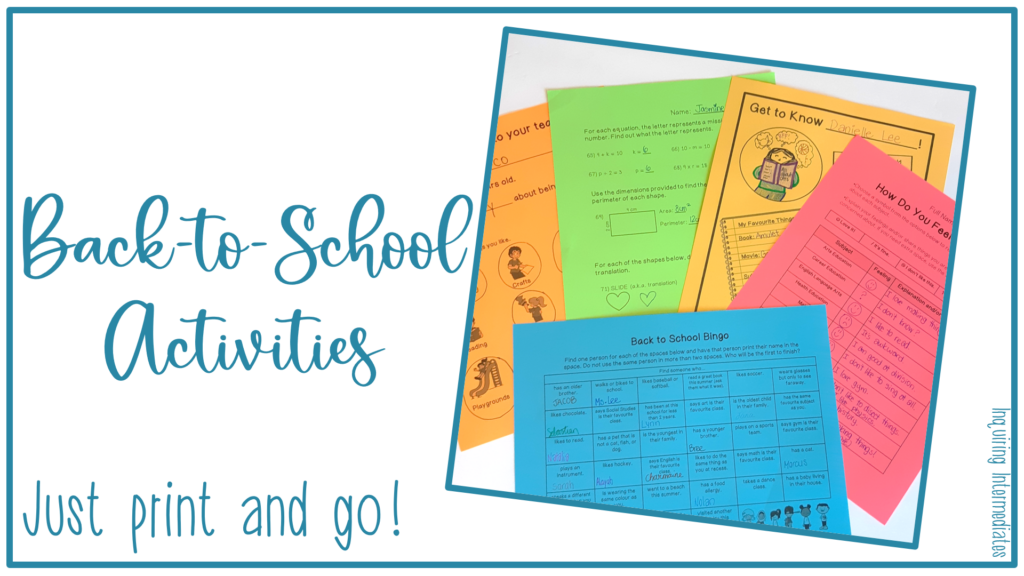The first week of school…
For the first week of school, my goals are always the same:
- Choose intentional activities to build classroom community, introduce the kids to each other, and help them get to know me.
- Figure out who my most needy students are. This can be students who are struggling academically, thosewho are going to need a challenge in order to stay engaged, or those who need extra social-emotional support.
- Establish routines and expectations.
- Show the kids that we are going to have a fun year!
Activities to Build Classroom Community
Icebreaker Activities
I’m a bit of a hypocrite when it comes to icebreaker games. I always dread them a bit when I have to do them as an adult, but I’m all about those icebreaker activities to build classroom community with students! I also hope to establish that we are a group that can have fun together. We start every morning with an ice breaker game for a few weeks. There are tons of ideas for icebreaker games online to choose from! You can keep it simple or go more elaborate. If you’re looking for easy icebreaker games you can hit the ground running with, check out my Back-to-School Icebreaker Game Slides for five project-and-go slides with instructions for icebreaker games you can use in your classroom.
Back-to-School Bingo is a staple in many teachers’ Fall routines. It’s easy to explain and it’s a great way for students to get to know each other. All you have to do is print out the cards and send students off to find people that meet the criteria in the squares! You can do this in one day or over a course of several mornings. Doing it a few times gives students a better chance of filling in their whole sheet and gives them better chances of remembering new names since fewer are being introduced at a time. You could also give kids a Back-to-School Bingo sheet without setting aside time specifically for them to fill it out. This could be a way to encourage kids to engage in conversations with their peers. These Bingo sheets are easy to make – you could even pass a blank one around, have each student write a square, and copy a class set of the completed version! Or, if you’re like me and you don’t want to do any last-minute copying, a pre-made version is included as a bonus in my Back-to-School Bundle.
Read-Alouds for Classroom Community
Read alouds and discussions are fantastic activities to build classroom community! Shared experiences and stories can really help bond a group together. There are two books I have started every year off with: You Hold Me Up and Tiptop Cat.
You Hold Me Up, by Monique Gray Smith, is a simple picture book where the protagonist lists ways people in her community “hold” them up. As a class, we brainstorm what holding one another up can look like. Then each kid creates their own illustration that says, “You hold me up when ___________.” I like to get student work on the walls as soon as possible to make the space feel more like ‘ours’ and less like ‘mine’.
Tiptop Cat, by C. Roger Mader, is a gorgeous picture book about a cat that falls off a roof, gets scared to climb back up, but eventually faces their fears and manages to enjoy the view once again. After reading this book, we talk about how we expect that mistakes will be made and failures will happen this year; the important thing is that we face our fears and try again.
This summer, I found another book that I’m pretty sure will be entering my back-to-school read-aloud canon. It’s called What Are Your Words? A Book About Pronouns. The very simple story by Katherine Locke does a good job of clearly explaining the idea of personal pronouns to kids. I’m going to read it before I hand out my Student Information ‘forms’, where they’ll be asked which pronouns they want us to use when we refer to them.

Life Groups
If you’re genuinely looking for activities to build classroom community, you’ve got to give life groups a try. This simple routine is quick, easy to introduce, and so effective! Check out this blog post to learn more.
Assessing Student Needs
Comment and Question Cards
One way to collect meaningful student information is to ask kids to submit questions, concerns, comments, or suggestions anonymously. I like to give each student a piece of scrap paper and a few minutes to put something on that paper before folding it up and handing it in. I ask that they all put something on the paper, even if it’s just a doodle. I also tell them that if there is something weighing on them that they just need to get off their chest anonymously, this can be a place for that too. Once everyone has handed their papers in, go over the slips and take out questions, concerns, or suggestions so you can address them with the class. The information that students share may help you make instructional decisions or let you know if particular groups are going to need extra representation. Making sure everyone is represented is a key way that you can help build a healthy classroom community.
Letter to My Teacher
Getting students to write a letter to their teacher is a good way to get an idea of who they are, what their needs are, and what matters to them. It can also double as a sneaky writing sample of sorts. This pre-made Letter to My Teacher template encourages students to tell their teachers what they need to do their best learning, outline their hopes and dreams for the year, and share what is important to them. I have also included an adapted version with fill-in-the-blanks and pictures to circle so students who struggle with writing can tell you what they like.
Student Information Forms
I have two versions of my Student Information forms: one for the kids, and one for their guardians. The questions are essentially the same, but I like to get different perspectives. The last two questions are just on the guardians’ versions since I give students a chance to answer them when they write the letter to their teacher. Last year, I sent the guardian forms out digitally, which could be better than paper if you don’t want guardians to worry their kids will see what they have written. The forms ask:
- What name do you want us to call you? (Student form only)
- Pronouns you want us to use to refer to you / Pronouns you use to refer to your child
- What language(s) do you/your child speak at home?
- Do you have internet access at home?
- Do you have access to a device you can do schoolwork on at home (ex. laptop, iPad, etc.). If so, what do you have?
- What do you love about yourself / What do you love about your child?
- What are your hopes for your child’s school year?
- Is there anything you want me to know about your child?
Academic Assessments
Before you get too deep into planning your lessons for the year, it’s important to see where your students are at academically. Personally, I focus on figuring out where we need to go in English and Math first. We work on a short article with some reading comprehension questions, and I give all the students this math assessment that covers all the concepts from kindergarten through grade five. For the math assessment, I make it very clear that they are not expected to know all the answers and are expected to skip things they don’t know. Naturally, they shouldn’t expect themselves to magically know the grade five concepts on the first day of grade five!
I tell them that we will be revisiting this assessment periodically throughout the year so they can see how much they have learned. It’s always neat to watch kids fly through it at the end of the year! When I hand out the assignment, I always put out some colouring pages too and let kids know that they can stop once they’ve done what they can and move onto colouring, reading, or drawing instead.
I also love to get an idea of how students feel about particular subjects. It’s fascinating to see how they change throughout the year; I often have kids who say they “hate” social studies at the beginning of the year tell me it’s their favourite subject at the end. Getting an idea of how kids feel about certain subjects tells you where to focus your enthusiasm. It can also tell you where students may need more academic support, as we tend to be less excited about subjects that are difficult for us. My Back-to-School Self-Evaluations are editable and allow you to add just subjects that you want to know about. I have also included an adapted version featuring images where students respond with just symbols and no words.

Getting to Know the Teacher
One of the first things I do to help students and families get to know me is send home a Meet the Teacher letter. This letter tells them a bit about my educational background, my hobbies, and my expectations. It outlines the three rules in my classroom and my homework policy (which is that I don’t assign any, but students need to take unfinished work home). If we have our prep schedules ready, I’ll include that too. I also like to have a blurb introducing their science teacher, since I platoon with another teacher for socials and science. As that isn’t a school-wide practice, it definitely requires some explaining. If I know we’re going to have a student teacher, I might also ask them to send me a blurb as well so families can be prepared for their arrival.
Abby Gross from Write on with Miss G is full of great ideas for back-to-school. Her Investigate the Teacher activity is so much fun! Rather than rehashing it here, I’ll link her back-to-school posts for inspiration.
Establishing Classroom Routines and Expectations
Classroom Rules
I have three classroom rules that sum up my expectations for the year:
- Respect yourself, others, the environment, and our supplies.
- Be prepared.
- Eat healthy foods and drink only water during class time*
Now, I think I got this idea from Josie @ManiacsInTheMiddle. She posted a few years ago about how she played songs that represented each of her classroom rules and had students guess what the rule was for each song. The song’s I’ve linked are:
- Aretha Franklin’s RESPECT
- The Lion King’s Be Prepared
- The Beach Boy’s Vegetables
Honestly, figuring out the rules from these songs is dead easy, but the kids seem to enjoy the activity and the vegetable song is a good laugh.
*Would I bend this rule if a hungry kid only had cookies and juice? Absolutely. But this ‘rule’ is 50% to avoid spillage of sticky foods and crumbs and 50% to encourage families to pack a healthy snack and avoid sugary drinks if possible.

Expectations for Different Kinds of Walking, a.k.a. Unlearning School Expectations
There are a lot of things we expect kids to do in school that don’t necessarily come naturally. Walking in a quiet, straight line through a hallway is definitely one of them. I mean, when was the last time you walked in a silent, single-file line with your friends at the mall? One of the great things about being in a portable is that we have a little more freedom in that respect. When my students go to science, they don’t need to be in a line because they’re outdoors in a big space the whole time. However, when they walk through the school to get to the gym, for example, the ‘regular’ school expectations apply.
This may sound silly, but we go on practice walks at the beginning of the year. We practice getting to the school doors (no line necessary and you can talk, just don’t be obnoxious in front of the classroom windows), lining up outside, and walking to various classes (in a line, quietly, without staring into the other classes like you’re watching a zoo animal).
Believe it or not, the hardest part of this is often the part where they’re not in a silent line. By grade five, we’ve usually trained them pretty well. Yes, I could just have them walk in a straight, silent line to and from portables and from our classroom to the school building. But learning to walk as a group is a skill, so why not practice it? If you’re socializing, you need to keep pace with your partner. If you’re walking through a crowd, you need to stay together without bulldozing anyone.
You might now be in a portable, but ask yourself: are there things I can help my students ‘unlearn’ so they can actually function properly in social contexts outside of school? For example, I once had a teacher who encouraged us not to raise our hands, but to jump in naturally like in a real discussion.
Expectations for Flexbile Seating (or… flexible-ish seating)
I don’t have a ton of flexible seating options in my classroom. Students have individual desks, we have a rainbow table, a big carpet, and several little carpets they can take wherever. No fancy flexible seating options, but flexible-ish seating.
In the first few weeks, I don’t let them sit wherever they want whenever they want. We start experimenting with small, short tasks. For example, they might be able to pick a spot for independent reading or a writing block. We review the expectations for finding a good spot and cleaning up after yourself a ton before they get free reign to sit wherever whenever during independent and group work.
Classroom Scavenger Hunt
Putting together a classroom scavenger hunt is super fun, and it doesn’t take a ton of time. Think of the places and items your students need to be able to find in your classroom. Here is my list:
- Fiction novels
- Non-fiction books
- Picture books
- Staples, hole-punchers, and other shared supplies
- Extra paper
- Math games
- Board games
- Classroom Lost and Found
- Waste bins
- Shared outdoor play supplies
- Emergency kit
- Phone (if you have one)
Count up the places/items on your list and pick a fun word or phrase with that many letters. For example, mine might be “WELCOME BACK!”. Make up a little card for each of these places. Add a description if you want. On each card, include the name of the item/place and one of the letters from your secret phrase. Tape the cards near the item or place they are for. Once students have found all the cards, they can unscramble the letters to figure out the secret phrase. To help them know what they need to find, you might write the list on the board or print one out for them. Want to take this activity to the next level? Have students draw a map of the classroom and label each location from the scavenger hunt!
My Favourite Back-To-School Activity: Let them eat cake!
And this brings us to one of my all-time favourite activities to build classroom community: celebrating back-to-school with a First Day Cake! I hate using plastic cutlery and I can’t be bothered to buy paper plates, so I’ve been known to just give kids their cake on a paper towel or napkin. And you know what? I’ve never had a complaint about unexpected cake.
Ending the first day with a piece of cake ensures that students leave with a smile on their face, which helps put their minds at ease and their guardians’ too. And honestly? It puts a smile on my face too. Just be sure to know that allergy list and ensure you have a treat for all your students.

Did you try any of these activities? Do you have any suggestions? I’d love to hear about your back-to-school activities to build classroom community and start the year off right!



